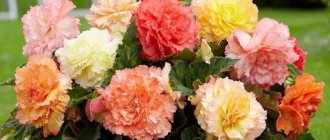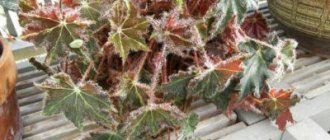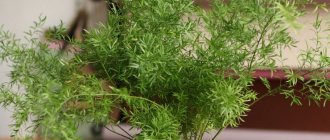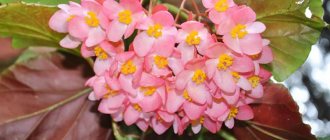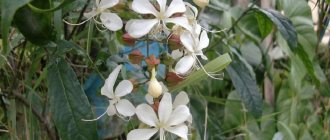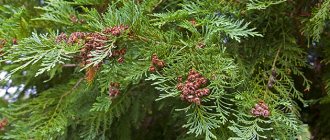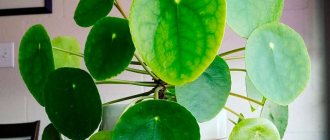Tuberous begonias bloom profusely and brightly, their luxurious flowers resemble roses, carnations, camellias, peonies, daffodils... The great advantage of tuberous begonias is their ability to add festive decoration to the shaded corners of the garden, bringing their bright colors there. Numerous elegant flowers of various tuberous begonias decorate gardens from June to September, and apartments and frost-protected balconies even longer - from late spring to late autumn.
Begonia tuberous. © Maja Dumat
Tuberous begonia (Begonia x tuberhybrida). A herbaceous plant with a thick underground tuber-rhizome, succulent translucent stems, height from 20 to 80 cm. The leaves are alternately arranged, heart-shaped, asymmetrical. Flowers, depending on the variety, are simple, semi-double, double. Colors range from white to dark red, yellow, orange, except shades of blue, cyan, violet. The flowers are heterosexual, monoecious, that is, there are male and female flowers on the same plant. The shape of the flowers is single, semi-double and double. With additional pollination, tuberous begonia produces seeds well, of which 1 g contains from 80 to 120 thousand. Flowering occurs from May to November. In winter, begonia loses its leaves and enters a dormant period.
The name Begonia x tuberhybrida was proposed by A. Voz, since there was a large group of hybrids, as well as mutations from them, united by the presence of a perennial tuber. According to various sources, from six to nine species took part in the crossings, but the Bolivian begonia (Begonia bolimensis) is considered the main one. The first hybrid varieties went on sale in England in 1869 and were grown in greenhouses as beautiful flowering plants for rooms. The Belgian Louis Van Houtte was the first to cultivate begonia in open ground. Thanks to his work, begonia tubers began to be grown almost like tulip bulbs, and the city of Gand became the world center for tuberous begonia. In the 90s of the last century, about 50 million tubers were produced there per year.
The selection of tuberous begonia proceeded very quickly, since the hybrids produced a lot of seeds, and the original species were distinguished by great diversity in flower shape and color. Already in 1874, V. Lemoine introduced gardeners to terry begonias. To this we can add that by the end of the 19th century there were about 200 names of forms and varieties. In a relatively short period of time, by 1900, hybrids with all the characteristic colors and double flowers went on sale. Further selection led to the creation of garden groups with flowers of various sizes: giant (gigantea) - up to 20 cm, large-flowered (grandiflora) - with flowers whose diameter is 8-10 cm, abundantly flowering (floribunda) - 8-12 cm and multi-flowered (multiflora ) – 5-7 cm in diameter.
Nowadays, selection proceeds in two directions. The first of them is the creation of heterotic hybrids, more suitable for open ground. Most often they are grown annually from seeds. The second, more traditional, direction pays more attention to the variety of flowers in color and shape. Such varieties are most often sold as tubers, although heterotic hybrids can also be sold as tubers.
The varieties and hybrids of the gigantea group are distinguished by the greatest variety in the shape of flowers and petals. Double flowers resemble camellia, peony or anemone. The petals of large flowers can be heavily ruffled or gathered (form crispa), or cut or fringed (form fimbriata).
A special place is occupied by ampelous tuberous begonias (Begonia pendula flore pleno), which were obtained by crossing various forms of the multiflora group. They have semi-double and double graceful flowers on thin drooping pedicels. But their advantage is not only decorative - they tolerate the sun well, bloom early and abundantly. Therefore, they are readily used in flower beds.
Begonia tuberous. © Laura Flanders
Tuberous begonia (Begonia x tuberhybrida) belongs to the genus Begonia. The genus contains, according to various sources, from 400 to 1000 wild species of plants of the begoniaceae family, growing in tropical and subtropical regions of America, Africa and Asia. Begonia was first introduced to Santo Domingo in 1690 by botanist Charles Plumiero.
The name of the genus Begonia comes from the name of the great lover and collector of the plant, M. Begon, who lived in Santo Domingo in the 17th century; C. Lineus, who described it, named begonia in his honor. In Russia, begonia has been known for a long time, and after the French fled from Moscow in 1812, it received an interesting Russian name - “Napoleon's ear”, since the outline and reddish color of the underside of the leaf of some types of begonia really looks like a large frostbitten ear.
Peculiarities
- Light : depending on the variety (some varieties are more tolerant of bright summer sun than others). In indoor conditions, bright, diffused light is better.
- Temperature : for normal flowering, depending on the variety, usually at least 10°C.
- Watering : regular in summer, without drying out. During the dormant period, the substrate with wintering tubers is occasionally moistened.
- Humidity : preferably high. For plants planted in containers, spraying is recommended.
- Feeding : in order for begonias to develop foliage, after planting, they need to be fed two or three times with an interval of seven days with potassium nitrate, and then with a complete complex fertilizer with a low nitrogen content.
- Pruning : fast-growing hanging begonias are pinched to form side shoots.
- Dormant period : in winter. It is advisable to store tubers in sand or peat at temperatures around 12°C. The rest period lasts about 3-3.5 months. To avoid drying out of the tubers, occasionally the substrate is carefully moistened.
- Transplant : annually at the end of the dormant period.
- Reproduction : tubers, cuttings, seeds (less often).
Origin
The tropics and subtropical zones of Asia, Africa and America are considered its homeland. The genus Begonia includes from four hundred to a thousand wild varieties.
In 1689, an expedition sailed from provincial Rochefort in France, heading to the West Indies. The team was faced with the task of describing the valuable plants of those regions. The expedition was led by Michel Begon. During the journey, Charles Plumiere discovered a strange flower that amazed the learned monk with its beauty. The researcher named the unusual plant in honor of the mission leader.
During the discovery and study of previously unknown lands, new species of begonia were discovered over time. The second half of the 19th century is the time of the first description of the tuberous variety. She became the progenitor of all large-flowering varieties.
Initially, they tried to create suitable conditions for the tropical plant by growing it indoors. But then species that were resistant to our weather conditions were bred. The flower moved not only into rooms on window sills as a potted crop, but also took pride of place in flower beds.
Know! Michel Begon himself never saw the flower that was named after him.
Dependence on growing conditions
The relationship of tuberous begonias to light varies. Plants with small flowers develop well in sunny places, while large-flowered plants grow better in partial shade. The same is true for ampelous forms: the smaller the flower, the better the plant feels in the sun. Both tall begonias with large flowers and hanging begonias should be planted in places protected from the winds so that the fragile succulent shoots do not break.
Begonia tuberous. © Maja Dumat
Due to its complex hybrid origin, the attitude of different groups of tuberous begonia to the temperature regime is different. If in general this plant can be considered more heat-loving than ever-flowering begonia (B. semperflorens), then the most demanding varieties of large-flowered begonias are the most heat-demanding, and the heterotic hybrids of the floribunda group, which bloom well at a temperature of about 10°C, are relatively cold-resistant, while In large-flowered begonias, at this temperature, flowering weakens, and the buds may fall off. None of the varieties of tuberous begonia can tolerate even light frosts. Plants especially suffer from cold winds; the edges of their leaves may turn black. But hot, dry weather is not conducive to good growth and flowering. In dry, heated soil, the roots stop growing and may die completely, flowers, leaves and buds fall off, and an almost bare stem remains. Begonia reacts poorly to low air humidity.
All begonias are moisture-loving plants; with a lack of moisture, their leaves become dull and their buds fall off. But excess moisture causes various rots to appear.
In places exposed to the wind, plants suffer more, especially dark-leaved varieties and hybrids. It can be assumed that only heterotic hybrids with small flowers can grow in open flower beds.
Caring for begonia at home
Despite such diversity, care for all types is approximately the same. In order to grow a healthy plant with painted leaves or lush flowering bushes, you need to pay attention to the following nuances:
- Lighting. Begonias do well on bright windowsills, protected from direct sunlight. Some decorative foliage species do well in shaded areas in the back of the room. Decorative flowering varieties require light. My beauty pleases with long-term flowering near an east-facing window;
- Temperature regime . The optimal level is 18-20 degrees, but in the summer, begonias tolerate higher values. Still, try to adhere to the specified norm. Begonia also does not like sudden changes in temperature, so do not rush to take the flowerpots out into the open air until persistent warm weather sets in;
- Air humidity. Begonia is native to the tropics, so you should stay as close to a humid climate as possible. The plant tolerates the heating season especially poorly. Spraying is contraindicated for all types of begonias; the problem is solved by installing special humidifiers. If you are not ready to spend money, you can get by with a tray filled with pebbles or moss. Pour water into it, and place a pot with a plant on top;
- Watering. Begonias cannot tolerate waterlogging; this is the most common cause of death. Watering is necessary if the top layer of soil has dried to a depth of at least 2-3 cm. The optimal method of moistening is watering through a pan. I water my plants once or twice every 7-10 days. I fill the pot with water and immerse the pot in it for 15-20 minutes, take it out and let the excess water drain well. Garden begonias are watered carefully, trying not to get on the above-ground part of the plant;
- Drafts. A very important point. Begonias love space and fresh air, but they absolutely cannot tolerate drafts and windy balconies and terraces. If you take the flowerpot outside, be sure to install a protective screen.
Landing
It is better to plant tuberous begonia in open ground in early June. On closed loggias it is possible earlier - in mid-May. If the temperature drops, it must be covered. Purchased seedlings, including flowering ones, can be kept at home in a bright window, but not in bright sun, providing it with sufficient humidity.
When planting, you need to very carefully remove the seedlings from the pot, especially if they are overgrown, since the succulent stem can easily break. Seedlings from seeds are buried 1-1.5 cm lower than they were in the pot. Tall seedlings and plants obtained from tubers should be planted 2-2.5 cm deeper to provide stability. It is recommended to place slowly dissolving fertilizers containing potassium and phosphorus in the hole and pour them well. It is better to plant tall varieties of begonias in flower beds at a distance of 30-35 cm from each other, compact hybrids - at 25-30 cm. They are planted in containers, especially ampelous forms, at 10-15 cm.
Begonia tuberous. © Maja Dumat
Begonias - varieties, planting, cultivation, care and reproduction
Today, no one would remember the governor of the island of Haiti, Monsieur Begon, if not for his exceptional love for rare plants. Michel Begon organized and sponsored an expedition to study the flora of the West Indies, where the famous botanist Charles Plumier...
My acquaintance with begonia began with a nondescript leaf, broken off from some branch. The children and I were doing renovations at the school; there were a lot of flowers there, and it was not clear from which one the branch broke off. I brought this leaf home, put it in a glass of water...
I have begonias in containers on my porch. Is it possible to save it until next spring? Or is garden begonia grown only as an annual plant? What a pity if such beauty cannot be preserved?
Please tell me. If I plant seeds in February 2022 of ever-flowering begonia (begonia Vzglyad Red, begonia Vzglyad White, begonia Apple Color, begonia Novaya Zvezda yellow) and ampelous begonia (begonia ampelous Chanson dark red, begonia...
Good afternoon. I bought a flowering begonia at the store. It bloomed very beautifully and for a long time, with a “cap”. By autumn, the flowers gradually flew away. At the moment, the green stems have grown a lot. How to make it bloom again?
Question from our subscriber Alexander: My problem is the following: 2 months ago I bought a Begonia bush in a pot, immediately transferred it to a slightly larger pot, and all these 2 months it delighted me with beautiful flowering. I watered it once...
Question from Natalia, our subscriber: Last year I bought a scarlet tuberous begonia, it bloomed very beautifully, it was well preserved in a hole in the garage, and before planting it was treated in a special solution for tubers. I planted it, the sprouts are already large, but...
Good afternoon A week ago I bought a beautiful blooming begonia from the greenhouse. After a few days, the flowers began to wither, turn brown and fall off. Then it was the turn of the leaves. They curl up, yellow spots and fall off. Please tell me how to save...
Good afternoon, dear flower growers. I would like to ask for your advice. I bought three tubers of BEGONIA MARMORATA in the store. They are quite large, with sprouts, but without roots. I keep them in a damp environment, the sprouts are good, cheerful, plump. And here…
Hello! Today they brought me two begonia cuttings. How to root correctly - in water or in a pot of soil?
Tell me the type of begonia in the photo. First flowering on November 25, what to do after flowering? What variety of begonia blooms from April, began to shed its leaves on December 1
What type of begonia is in the photo? The first flowering began on November 26, it will bloom in the winter, but what will happen to it in the spring? Is this a tuberous begonia or not?
Hello. Is Go-Go Selmon begonia sold as seeds or tubers?
The top of the begonia broke off, and it has been sitting for 2 months without any signs of growth. What should I do in this case to make it bloom?
Can begonia be planted in open ground?
Good afternoon Has anyone grown tuberous garden begonia by cuttings? The tuber overwintered in a box of ash, when buds appeared, I moved it into a flower pot. Now the begonia looks like this: see photo. Probably, it was necessary to divide the tuber...
Hello. My begonia got sick. Maybe I flooded it? Please, advise something. Begonia
Hello! We need an expert answer)). I bought the seeds of the yellow multi-flowered New Star begonia. The seeds came in... I planted them, everything was great, but now the question arose, what will happen to these beauties next? The description of the seeds says that you can...
There is very little information on Russian-language resources about caudex begonias. This situation saddens me because I really loved these plants. Photo from the site kaudeks.ru In my home collection there are three species (varieties?) of these begonias:…
They gave me a begonia, more than a month has passed. I noticed that it was starting to rot. I water it every 5-7 days (I put it in a basin for half an hour, then I let the water drain, I don’t leave it in the water), I can spray it a little twice a week. But often I don’t keep track, and dad waters...
Tell me, is this a tuberous begonia? What to do after flowering? Do I need to dig it up in the fall?
7dach.ru
Care
The main thing in caring for tuberous begonia is proper watering. To maintain flowering in hot, dry weather, you need to water early in the morning, but not with cold water. When watering during the day, burns appear on the leaves, and subsequently they fall off. If you water overheated soil with cold water, the roots will die.
To increase the resistance of plants when heat sets in, they need to be sprinkled with growth substances (humate, epin, zircon). It is advisable not only to water begonias in containers, but also to spray them with warm water in the morning and evening.
In order for begonias to develop foliage, after planting they need to be fed two or three times with an interval of seven days with potassium nitrate, and then with a complete complex fertilizer with a low nitrogen content. Excess nitrogen causes plants to stretch out and, in damp weather, contributes to their rotting.
Until the plants grow, it is necessary to keep the soil loose and remove weeds.
Tall begonias with large flowers should be tied to small stakes to prevent them from breaking in the wind or during heavy rains.
In containers, fast-growing ampelous begonias are pinched to form side shoots. In addition, to prevent the shoots from rotting when they become very thick, it is recommended to either distribute them throughout the container or remove excess and weak ones.
Description of the terry begonia plant
Terry begonia belongs to the flowering class. In the wild, the plant prefers a humid climate. Wild begonia can be found in tropical and subtropical climate zones.
What does terry begonia look like?
For your information! The Frenchman C. Plumier first saw the flower in the Antilles in 1687, after which its active domestication began. Breeders have developed various varieties that are adapted to cultivation in temperate climates.
Begonia fascinates with its beautiful green or reddish foliage. The buds are brightly colored. Petals with a terry border around the edges. The root system of a flower can be tuberous or bushy. According to the nature of their growth, bushes can be either ampelous or ordinary. Tuberous begonias have large buds measuring 20 cm. Ampelous ones are planted in hanging flowerpots and flower pots.
Ampelous variety Venus
Among the famous varieties are:
- Fortune. A compact plant up to 25 cm high. The buds are located on a short stalk above the foliage. Flower diameter is 6-8 cm. Flowering is long and abundant. Begins to bloom earlier than other varieties;
- Fimbriata pink. An evergreen bush with lush and large flowers of a bright pink hue with a fragrant aroma. Blooms for 2-3 weeks;
- Venus. It stands out for its large semi-double flowers and picturesque greenery;
- Grandiflora. A plant with large flowers up to 20 cm in diameter, resembling roses in appearance;
- Non Stop Mix. A low plant with large inflorescences. The variety is famous for its continuous, one might say, eternal flowering throughout the entire season. The buds are yellow, white, red, pink;
- Marmorata. The variety fascinates with marble-colored buds with scarlet and white tones;
- Double white. White double begonia with large flowers and dark green foliage;
- Bella. The inflorescence is large, lush, snow-white.
A very impressive variety of Marmorata
Note! Begonia blooms from early spring until late autumn. Ever-blooming begonias are also found. In winter, the leaves do not die off, but remain on the bush.
Overwintering, propagation by tubers
At the end of August, before frost, you need to decide what to do with the tuberous begonia next: leave it at home for further flowering or dig it up to obtain tubers. In the first case, the plants are transplanted into a pot, preserving the root system if possible. In the second, without cutting the stem and leaves, they dig it up with the largest possible lump and place it to dry in a well-ventilated, shady place, protected from rain.
With a short autumn day, the leaves gradually dry out, and nutrients from them enter the tuber. Thus, a large tuber is formed within one month. In industrial cultivation, in addition, at the moment of mass flowering, flowers are removed from plants.
At the end of the growing season, begonia should be covered from frost at night with paper, gauze or plastic wrap. After flowering, begonia goes into a dormant state. During this period, watering is reduced and the plants are moved to a dark place. After about 1-1.5 months, the above-ground part of the begonia dies, after which the tuber is left in the ground for another 2-3 weeks. After this, the tubers are dug up and placed in a box with sand or peat. The substrate in which the tubers are stored is slightly moistened from time to time so that the tubers do not dry out. The box with tubers is kept in a cool room with a temperature of 12-14°C. 2-3 months before planting in balcony boxes, the tubers are removed from the sand and planted in pots with soil. Tubers have an upper and lower part. On the upper part, which is flatter or concave, there are buds that look like bumps and bumps. The lower part is smoother, slightly convex, and roots will form on it after jigging. Tubers germinate well at a temperature of 22-24°C and regular watering. Old tubers can be cut into 2-4 parts, so that each piece has 3-4 buds. It is advisable to sprinkle the cut areas with charcoal powder.
Begonia tuberous. © Maja Dumat
When purchasing tubers, you need to pay attention to their size and type. The diameter should be at least 3 cm; for ampelous small-flowered begonias it is slightly smaller. Well-cleaned tubers should be smooth and dense at the top.
Selection of tubers and growing features
The plant comes from Africa and South America .
It is because of this that problems may arise when growing it, since the flower is light-loving and also requires moist soil. And the climate in our latitudes is changeable and colder. Some gardeners believe that begonia cannot be grown on their own plot, it should only be an indoor flower. But it is not so. Certain varieties will decorate the area with their flowers throughout the summer.
When purchasing begonia bulbs, you should contact only specialized stores . It is best to do this in February, since it is at this time that deliveries of the plant from Holland begin. Don't wait for prices to drop. This may indicate that the product is of poor quality. As a result, the sprouts will not sprout.
Important! The tubers should be firm and not overdried. It is imperative to ensure that there is no plaque or traces of mold on them. The contents of the package are carefully inspected before purchase.
You should select only those specimens that already have awakened buds.
Seed propagation
Begonia seeds are very small. To obtain them, flowers are artificially pollinated, for which pollen from male flowers is transferred with a brush to the pistils of female flowers. To get flowering begonias in summer, the seeds need to be sown in December-January in leafy soil, and should not be sprinkled with soil.
The container with the planted seeds is tightly covered with glass to prevent the top layer of the substrate from drying out. The optimal temperature for seed germination is 22-25°C. The earth is periodically moistened. The glass needs to be opened slightly from time to time to prevent excess moisture and mold. Shoots appear in 14-16 days.
Dive in the state of two cotyledon leaves into deciduous soil at a distance of 2 x 2 cm at a temperature of 20-22°C, after which they are covered with glass for 2-3 days. When the leaves are closed, a second pick is made at a distance of 4 x 5 cm, and then a third - after 6 x 7 cm.
The soil mixture for the second and third pickings consists of 2 parts of deciduous soil, 1 part of turf soil and peat, and 0.5 parts of sand (mixture pH 6-6.5).
After the third pick, when the leaves close, the begonia is planted in 11-13-centimeter pots with a lump of earth, adding 1 part of deciduous soil, a little bone meal and ground dry cow manure to the soil mixture.
After planting, water abundantly and lightly shade.
Begonias often turn out to be tall and unstable. To avoid this, during the formation of 5 leaves, plants are sprayed with a growth regulator (retardant) - chlorocholine chloride (0.5% solution, 20-30 ml per plant), which inhibits growth. Under its influence, the plants have a compact, low bush with numerous flowers.
Young plants are planted in balcony boxes after the spring frosts have ended, at a distance of 20 cm from each other.
When propagated by seed, plants bloom on the 135-150th day after planting.
Begonia tuberous. © Darorcilmir
Add some color to your life by planting a 'begonia marmorata' flower.
Begonia is a genus of herbaceous and perennial plants with beautiful, bright flowers. They come in the form of shrubs, creeping vines or subshrubs. A wide selection of different colors allows this plant to be an excellent decoration for the garden and home.
For a winter garden or apartment, a variety called begonia Marmorata is planted. This plant has large double flowers. Begonia Marmorata differs from other varieties in the bright colors of white flowers, which are covered with small red strokes. Each petal of the flower is edged with a red border, which gives this coloring a finished look. Fimbriata begonia, whose flowers have a carnation shape, looks great in joint plantings with it. This variety is often called terry begonia.
Any plant from the begonia genus has asymmetrical leaves, flowers of various shades and several types. Variegated varieties of begonias that bloom in the cold season are used for growing at home. When selecting begonias for decorating and beautifying a site, only three types are mainly used: tuberous, Viennese, ever-flowering and ampelous pendula begonias. Growing conditions are the same for any species.
By choosing the variety, Begonia Marmorata, you can improve your area. With its help, you can add color accents to flower beds or outline the edge of a path. Begonias tolerate shade well. Therefore, it can be planted in any corner of the garden. But if you want to enjoy abundant flowering, then place it in a sunny place.
You should be attentive to changing weather. This beautiful flower does not tolerate even slight frosts. Before planting, you will need to arrange good drainage of the flower bed, because stagnation of water can destroy the plant. Begonia loves acidic and rich soil mixtures. Hanging varieties will look great in hanging flowerpots or baskets. Begonia Marmorata will take root well on a rocky hill, in ridges, in containers and just in a flower bed.
Having planted this beautiful plant, you should know the features of caring for it. This will make it possible not only to increase the number of flowers, but also to increase the duration of flowering. To do this, you only need to reduce watering the bush, starting from the moment of flowering. The plant requires several mineral and organic fertilizing during the summer.
Begonia planted on the site must be dug up before frost and transplanted into a pot for further growth at home or put it in a dry, dark and cool place until germination, which should begin in February. Having grown a small bush in a few months, you can plant it on the site. But you don’t need to do this before the end of May or even the beginning of June. After all, it is during this period that warm weather is already established.
Having one begonia bush, I really want to propagate it as much as possible. This can be done by dividing tubers, propagating by cuttings and planting seeds. When planting begonia seeds, keep in mind that they are very small and it is better to mix them with sand. It is enough to sprinkle them on top of the ground and cover the container with film or glass. We plant seedlings in the garden plot no earlier than the beginning of June.
Having chosen the propagation method using cuttings, you should germinate the tuber in January and break out several grown ones, dusting these places with crushed activated carbon. The easiest way to propagate begonias is by tuberous. Already in January we begin to germinate tubers. We cut each tuber into several parts so that each part has several eyes. Then we dust the sections with ash and plant them in the usual way. This procedure should be carried out in the spring.
Begonia is susceptible to infection by many diseases and damage by pests. Therefore, it is necessary to carefully care for it.
fb.ru
Propagation by cuttings
When propagating by cuttings from well-developed plants, cut off the apical part of the stem 6-10 cm long with several leaves. The lower leaves on the cut cuttings are removed, and the cut site is sprinkled with charcoal powder, after which the cuttings are planted in sand, watered and covered with a glass jar. The jar needs to be lifted from time to time to avoid excessive moisture. The cuttings take root in about 2-3 weeks. After this, it is transplanted into nutritious soil. The advantage of propagation by cuttings over seed propagation is that the plant obtained in this way retains all the characteristics of the mother plant.
Forum, reviews
Judging by numerous reviews on the Internet, gardeners are faced with a number of typical problems when growing begonias. For example, forum member Marina is concerned about the lack of flowers on her pet. Experienced lovers tell the beginner that the tropical plant does not like direct sunlight and it is better to shade the pot or move it to a northern window sill.
The vast majority of users admire not only the visual appeal of the plant, but also its versatility. Many summer residents are happy to share their experience of growing in flower beds.
Often admirers of guests from the tropics discuss the most effective ways of propagating it. They consider cuttings to be the most preferable.
Questions arise about the quantity and regularity of watering. Recommendations on this issue remain relevant. Before you acquire a wonderful flower, it is useful to carefully re-read the section on this topic again.
Wintering problems also concern many. Some users advise storing planting material in the refrigerator. Others prefer a seat on the balcony.
Alena, Yekaterinburg. — I recently bought this beauty. It looks absolutely amazing. But caring for her tires me a little. It is not always possible to maintain optimal air humidity, especially if I am at work for a long time. As a result, now the bush does not look as perfect as when it was purchased.
Tatiana, Stavropol. — Very beautiful, luxurious flowers. I patiently look after my charges. Some will say that they require a lot of attention. In part, this is true. But they also please the eye, and this is very important.
Tamara, Krasnodar. — Recently I was given such a flower. He is very bright - he gives so many positive emotions. Friends have already told stories of how their seedlings refused to bloom in the future. I hope I can cope with leaving and this problem will bypass me.
Indoor culture of tuberous begonias
At home, tuberous begonia, purchased as seedlings in a pot, will bloom in the summer in a fairly bright window, but not in the sun. If the pot is placed in soil or peat and watered moderately, this will provide normal humidity for growth and flowering.
If tuberous begonia is shaded too much or pots are placed on northern windows, it stretches out and loses its decorative effect.
Begonias bloom much better in boxes on a shady balcony or on the balcony floor. Plants in pots and boxes require regular feeding with complete complex fertilizers. In such conditions, begonias grown from tubers feel better and bloom more profusely.
How to plant correctly
It is not difficult to grow home begonia, the main thing is to provide competent care, attention and care. In order for the plant to delight with its abundant flowering, it is important to choose the right soil and fertilizing, follow the rules of watering and maintaining humidity, and monitor the temperature and lighting.
Soil selection and fertilizing
Why doesn't Begonia bloom at home?
Light crumbly and fertile soil with enriched minerals is suitable for planting. The soil composition should include: peat, humus, leaf soil. Begonia is fed with phosphorus-potassium and nitrogen fertilizers. The introduction of the former will increase the flowering period and the abundance of inflorescences. Nitrogen fertilizer is usually used for deciduous varieties or after flowering. They inhibit the development of buds, but promote the growth of leaves and stems.
To grow a flower at home, use complex fertilizers:
- Kemira Lux;
- "Good Power";
- bona forte;
- "Mr. Color"
The bushes are also fertilized with folk remedies, such as yeast, sugar, tea leaves, eggshells, and banana peels.
Important! Indoor begonia needs to be fed once every 12 days.
How to plant in a pot correctly
Before planting begonias, you need to choose the right pot. It should be made of natural materials: clay or ceramics with drainage at the bottom. The porous walls of the pot allow air to enter the soil, allowing the root system to breathe. The depth of the pot is from 10 to 15 cm. For ampere varieties, a wider and shallower pot is suitable.
To plant a plant in a pot, you must follow the instructions:
- Before planting, the flowerpot should be disinfected with a weak solution of manganese permanganate and dried.
- The planting material is placed in a disinfecting solution for three hours and dry and dead ends are removed.
- A drainage layer is poured onto the bottom of the container.
- The soil is poured up to half the height of the pot so that the tuber does not extend beyond the edge of the pot. Ideally, 1.5-2 cm should not reach the edge.
- The tuber is placed in the middle and covered with soil. The top shoots will be open until the first shoots appear.
- At the end, the soil is moistened.
Note! The bulb is sensitive to sudden pressure, so planting must be done with gloves and very carefully.
Planting a tuber in a pot is done very carefully so as not to damage the bulb
Possible difficulties
Powdery mildew and gray rot can occur both in open ground and indoors. Powdery mildew occurs in hot, humid conditions. Gray rot is more common in cold, damp weather. In both cases, it is necessary to remove diseased leaves and increase ventilation. In case of severe damage, plants should be sprayed with special preparations.
The plant stretches due to lack of light and nutrients, or because the container is too small.
When the earthen coma dries out or becomes waterlogged, it becomes affected by powdery mildew.
In cold and damp conditions, gray mold may appear - it is necessary to improve ventilation.
When affected by leaf rot, plaque and brown spots appear on the leaves (you need to remove the damaged parts and treat the plant with a fungicide solution).
If kept excessively damp and cold, root rot may appear, as well as leaf spotting when water gets on them.
Yellowing of leaves is observed with a lack of light;
Brown, papery leaf edges indicate dry air or direct sunlight hitting the plant.
Begonia tuberous. © plantsrescue
When temperatures are too high and humidity is too low, plant leaves dry out and curl.
In low light (if the shoot elongates excessively), dry air (if the leaves are wrinkled), excess moisture (i.e. the leaves begin to droop), leaves may fall off.
If the air is too dry, lack of moisture or sudden temperature fluctuations, flower buds dry out.
If there is insufficient air humidity, the buds may fall off.
Pests and diseases
By following the basic rules for caring for flowers, you can avoid most of the problems that often arise with inexperienced flower growers. If begonias are not maintained correctly, insects may appear on the plants or the bush may become diseased. Very often you can find in begonia:
- dry foliage, which occurs against the background of overdrying;
- the appearance of transparent spots on the foliage is a sign of sunburn;
- falling off of greenery due to hypothermia;
- rotting of the root system due to stagnation of water;
- A decrease in the size of greenery and a decrease in the number of flowers is a consequence of a lack of minerals.
Powdery-type spots on foliage most often appear due to powdery mildew or gray mold. Diseases begin to develop against the background of a lack of light or when the level of air humidity increases. Diseases can be controlled by spraying with fungicides that contain benomyl.
Begonia diseases
Note! The most dangerous thing for flowers of the Begoniaceae family is the appearance of yellow rings on the green mass. They are formed against the background of tomato spot and cucumber mosaic viruses. Unfortunately, no drug can effectively deal with yellow rings. The affected plant must be destroyed.
You will have to get rid of the bushes even in cases where nematodes (worms whose size is in the range of 0.5-1 mm) appear in the root system and on the foliage of plants. The presence of worms can be recognized by the deformation of surfaces, the appearance of a swollen spot or growth.
In cases where begonia is not properly cared for, it can become infected with the following pests:
- scale insect;
- thrips;
- red spider mite;
- aphids.
In order to cope with insects, you will need to use insecticides. Treatment of a houseplant must be carried out near an open window to prevent air poisoning with chemical elements. If desired, you can spray the plant with a soap solution (250 g of laundry soap is required for 10 liters of water). Onion and garlic infusions and tobacco can also save home bushes from pests. For maximum effectiveness of treatment, the bushes will need to provide the correct climate in which pests cannot exist.
Growing begonias is an interesting and very exciting process. By caring for the bushes, you can soon enjoy the lush flowering of the plant.
0 0 votes
Article rating
Varieties
- Brautjungter . Group of fringes. The bush is compact, 25 cm high. The leaves are large, light green. The flower is double, white with a red border, 11 cm in diameter. Seed productivity 0.01 g. Looks good in group plantings, on ridges and in flower pots.
- Bouton de Rose. Rosaceae group. The bush is compact, 25 cm high. The leaves are green. The flower is double, pink, 18 cm in diameter. Seed productivity 0.02 g. Looks good in flower beds and vases.
- Gold Dress (Gold Platier). Rosaceae group. The bush is semi-spreading, 25 cm high. The leaves are light green. The flower is very double, large, yellow, 20 cm in diameter. The peduncle is spreading. Seed productivity is low. Looks good in group plantings and in vases.
- Guardsman . Rosaceae group. The bush is semi-spreading, 25 cm high. The leaves are dark green. The flower is double, dark red, 12 cm in diameter. Seed productivity 0.02 g. Looks good in group plantings and flower beds.
- Dak Red (Dark Red). Peony group. The bush is semi-spreading, 15-16 cm high. The leaves are bright green. The flower is double, with wide petals, dark red, 10 cm in diameter. Seed productivity 0.03 g. Looks good in group plantings.
- Diana Wynyard . Group of fringed. The bush is compact, 18-20 cm high. The leaves are light green. The flower is large, densely double, with wavy and folded petals, white, up to 20 cm in diameter. Seed productivity 0.01 g. Looks good in group plantings, vases and flower pots.
- Crown (Corona). Peony group. The bush is semi-spreading, 25 cm high. The leaves are light green. The flower is slightly double, yellow, up to 18 cm in diameter. Blooms profusely and for a long time. Seed productivity 0.33 g. Looks good in group plantings and on borders.
- Camellia Flora . Camelliaceae group. The bush is compact, 20-23 cm high. The leaves are green. The flower is pink, with a white border, 12 cm in diameter. The petals are arranged imbricately. Looks good in vases and flower pots.
- Crispa marginata . Group of folded ones. The bush is spreading, 15 cm high. The leaves are green, folded, with a thin purple edging. The flower is broadly oval, white, with a bright pink border, size 9x12 cm. The outer petals are wide, the lateral petals are narrower, the edges are strongly corrugated, wavy. Looks good in groups and in flower beds.
- Cristata yellow. A group of warts. The bush is spreading, 20 cm high. The leaves are green, folded along the edges. The flower is simple, yellow, 11 cm in diameter. On the central vein of the petals there are outgrowths in the form of a fringe. Looks good in flower beds and borders.
- Marmorata . Two-color group. The bush is semi-spreading, 20 cm high. The flower is double, scarlet with white streaks, 12 cm in diameter. Looks good in vases and flower beds.
- Orange . Peony group. The bush is semi-spreading, 16 cm high. The leaves are green. The flower is double, orange, 10 cm in diameter. Seed productivity 0.02 g. Looks good in groups and flower beds.
- Rose . Rosaceae group. The bush is semi-spreading, 20 cm high. The leaves are bright green. The flower is double, pink, 10 cm in diameter. Seed productivity 0.02 g. Looks good in groups, vases and flower pots.
- Salmon Rose. Rosaceae group. The bush is spreading, 18 cm high. The leaves are bright green. The flower is double, salmon-pink, 11 cm in diameter. Seed productivity 0.02 g. Looks good in flower beds, vases and flower pots.
- Scarlet . Rosaceae group. The bush is spreading, up to 20 cm high. The leaves are green. The flower is double, pink-scarlet, 11 cm in diameter. Seed productivity 0.04 g. Looks good in groups and vases.
- White . Rosaceae group. The bush is compact, 16 cm high. The leaves are bright green. The flower is double, white, 10 cm in diameter. Seed productivity 0.01 g. Looks good in groups and in shaped flower beds.
- Helene Tartalin . Group of fringes. The bush is compact, 15 cm high. The flower is double, white with a red border, 11 cm in diameter. Looks good in groups, vases and flower pots.
Varieties and types: description and photo
Tuberous begonia has several varieties and types. There are garden, indoor and wild varieties. The most common garden species.
Golden ball
A plant with a long stem and large large flowers that can reach 20 centimeters in diameter.
Diva
There is scarlet, pink and white . The flowers are large and have corrugated petals.
Kelblutrot
Perennial red begonia.
Marmorata
It has large white flowers with red splashes.
Watch a video about the tuberous begonia variety Marmorata:
Crispa marginata
The plant has yellow and white flowers . Along the edges of the petals there is a red border.
Fimbriata
The main feature is the pointed flowers.
Picoti
It has very lush flowers with a border around the edge. The color can be yellow, white or pink.
Chanson
Flowers are yellow, orange, white or red. Has double petals .
Margarita
Flowers are medium sized with yellow flowers.
The last two types are used for decorating walls and container growing.
Each variety of tuberous begonia is unique in its own way . This variety allows you to choose flowers that suit the overall decoration of the garden. With proper care, this plant will delight owners for many years.

